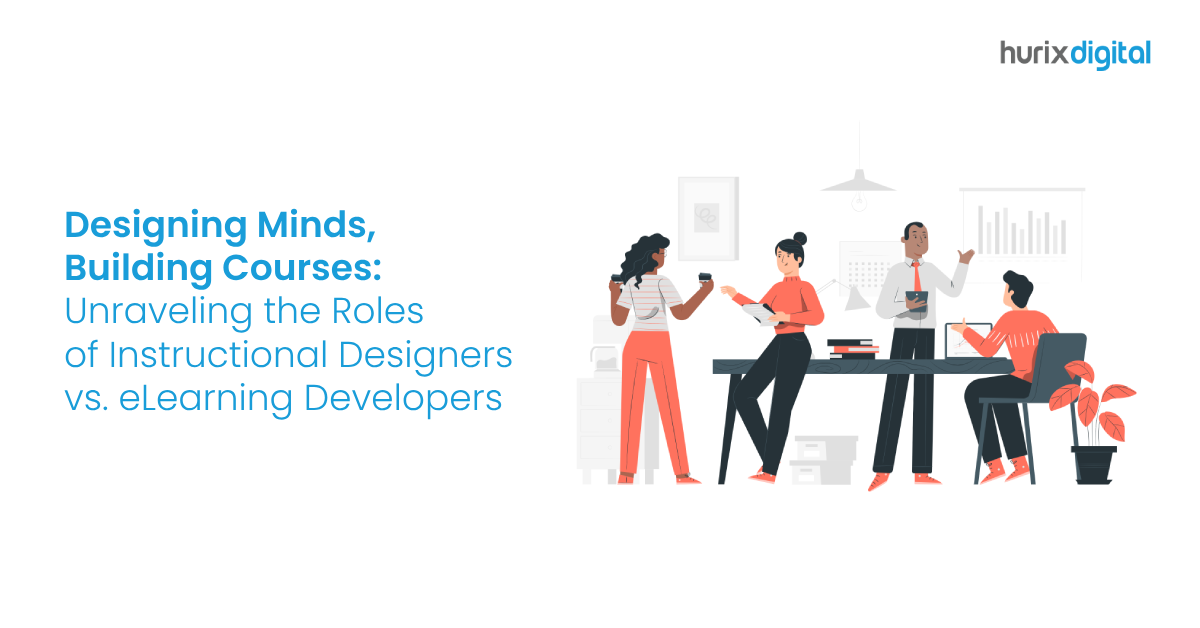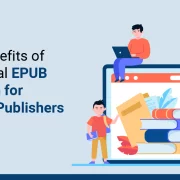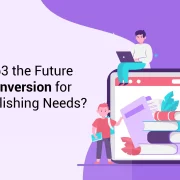
Designing Minds, Building Courses: Unraveling the Roles of Instructional Designers vs. eLearning Developers
Summary
Explore the distinct roles of instructional designers and eLearning developers. This blog provides insights into how each role contributes to course creation and development.
eLearning courses are playing a vital role in the present day’s higher education scenario. These attention-engaging and knowledge-driving programs are the handiwork of developers whom people interchangeably call ‘Instructional Designers’ or ‘eLearning Developers’.
In the context of higher education instructional design, the roles and specializations of both these profiles vary. An understanding of the same is required to ensure that the instructional content developed by them meets your expectations.
Table of Contents:
- Higher Education Instructional Design Professionals
- Putting Roles in Perspective
- Instructional Designers vs. eLearning Developers
- Wrapping It Up
Higher Education Instructional Design Professionals
In 2018, the US Bureau of Labor Statistics predicted that jobs for instructional designers would increase by 9% during the next decade. Instructional designers architect effective learning modules after comprehensive evaluation of their efficacy along with the impact on the student’s learning experience and behavioral changes.
The role of instructional design in higher education is essentially different from that of an eLearning developer. The former focuses on organizing learning content, creating immersive student experiences, and leveraging proven learning theories. In contrast, the latter’s role is more technical-oriented and relates to programming for online courses, developing multimedia content, and leveraging LMSs (Learning Management System).
The content below will help identify the difference between instructional designers and eLearning developers from a broader perspective.
Also Read: How to Choose the Right Remote Instructional Design Tools and Software?
Putting Roles in Perspective
Understanding the distinct roles of Instructional Designers and eLearning Developers becomes clear when you step into the educator’s shoes. Imagine yourself in need of an eLearning course to enhance student proficiency in a specific subject.
1. Role of an Instructional Designer
The instructional designers adopt an ISD (Instructional Systems Design) methodology that systematically analyses widely accepted and evolving learning models, principles, and theories.
These versatile professionals embrace an agile philosophy for architecting learning experiences by collaborating with SMEs (Subject Matter Experts). They organize content by focusing on learning theories that are well-evaluated to facilitate continuous improvement.
An instructional designer has the following responsibilities:
- Analyzing existing study content and organizing content in a logical hierarchy to meet the learning objectives.
- Analyzing skill gaps and learning requirements of students to suggest potentially functional solutions.
- Developing the structure or flow of the course curriculum with mock-ups, storyboards, course outlines, etc.
- Creating learning materials like instruction manuals, online programs, simulations, video tutorials, evaluative assessments, examination modules, etc. by applying relevant educational theories and pedagogic design principles for delivering immersive learning experiences.
- Designing quizzes, surveys, summative and formative evaluations, and other assessment measures to gain insights into the efficacy of learning materials.
- Evolving trenchant learning paths by accommodating vivid learning philosophies.
- Administering learning platforms and LMSs (Learning Management Systems) by facilitating the enrolment of new learners, updating content periodically, reviewing performance, and displaying assessment results.
- Leveraging insights from data analytics for updating and improving learning materials to keep pace with the changing educational dynamics.
2. Role of an eLearning Developer
An eLearning Developer gears up for their role once the storyboard or course planning script is finalized by the Instructional Designer. The developer, now, has in their possession all the assets and content guidelines needed for creating the final interactive and immersive course material.
In this context, the responsibilities of an eLearning Developer in higher education are:
- Inspect the storyboard to check the bottlenecks, if any (for example, some development needs may be beyond the scope of eLearning authoring tools) and resolve them with realistic solutions.
- Collaborate with the Instructional Designer to finalize easily implementable interactions by staying within the allocated budget.
- Create a custom programming roadmap to facilitate the eLearning module’s optimum functioning within the specified learning management environment.
- Develop a prototype of the storyboard’s blueprint with a good tool for rapidly authoring eLearning modules like Adobe Captivate or Articulate Storyline 360.
- Incorporate the entire array of assets specified by the instructional designer, and program and create animations to render the final eLearning module functional and in alignment with the specifications.
- Leverage skills in web development to create CSS, HTML, and JavaScript codes.
- Make courses more interactive with complex programming, gamification, videos, vector elements, and images.
- Edit images, videos, and other resources as and where needed in compliance with visual designing and multimedia deployment principles while respecting the proven practices for optimum learner experience.
- Develop engaging and visually attractive user interfaces and layouts for courses.
- Closely work with videographers, graphic artists, and voice-over professionals to create engaging content.
- Maximize the learning management platform’s performance to ensure compatibility of learning materials across various web browsers and devices for easy accessibility.
- Make provision for analytics and performance-tracking tools to realistically measure learners’ progress and the course’s efficacy.
- Work closely with the instructional designer to respond to client feedback and effect changes in functionality.
Instructional Designers vs. eLearning Developers
By now, you must have understood how the roles of instructional designer vs eLearning developer can be compared and contrasted from the perspective of developing meaningful eLearning materials.
- An instructional designer will assist you in defining the learning goals of the course. They will analyze which flow is best suited to optimize effective learning and will accordingly chalk out the content organization blueprint. The designer will collaborate with you to assess the most efficient way of presenting information and designing learning activities. This is to ensure that the learners can assimilate knowledge seamlessly.
- Once clarity on the course’s structure develops, the actual course content will be created by an eLearning Developer. They will choose the best LMS platform, build interactive and visually appealing content with multi-media inputs, and extensively test and deploy the same.
The aforesaid visualization showcases how the roles of both professionals complement each other. The foundation of an eLearning program is laid by the instructional designer. The actual program is technically developed and rolled out by the eLearning developer.
Also Read: Crafting Medical Mastery: The Art and Impact of Instructional Design in Education
Wrapping Up
The intricate relationship between Instructional Designers and eLearning Developers is vital in creating engaging and effective courses. Their collaboration results in innovative and impactful online learning experiences that cater to diverse learner needs. As the digital landscape continues to evolve, the roles of both professionals will remain essential in shaping the future of education and training.
At Hurix Digital, we will help you create engaging eLearning materials that can facilitate optimal nurturing of the desired skills in learners. Hurix Digital is committed to intellectually nourishing evolving minds with cutting-edge educational learning materials developed in sync with the rapidly changing academic landscape.
We excel in higher education instructional design as we understand that this exercise is not merely about curriculum design or technology leveraging, it is much more. Collaborate with us to re-align the learning journeys of your students with contemporary digital technology.

Senior Vice President – Business Development
Over 25 years of experience in the edtech and workforce learning industry with strong skills in Business Development, Customer Relationship Management (CRM) and Strategy.




